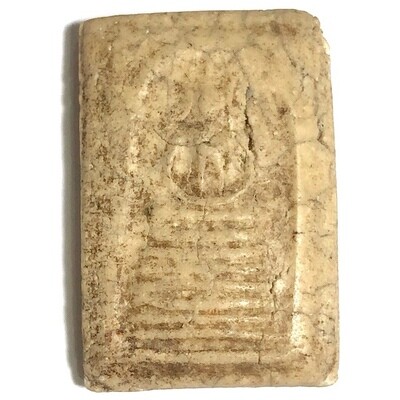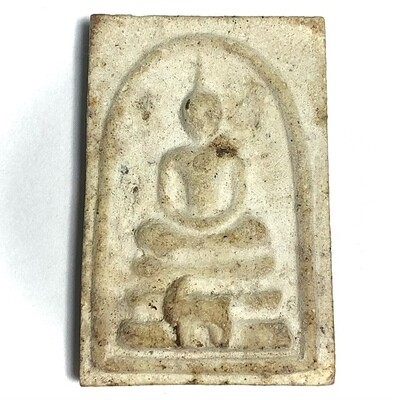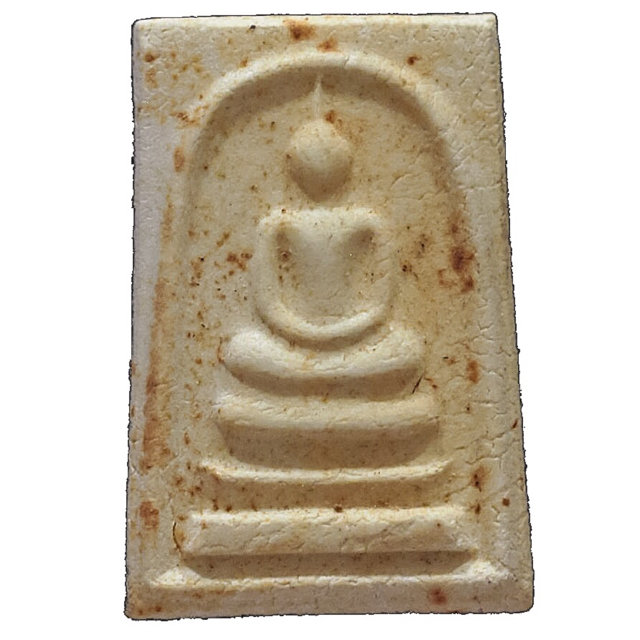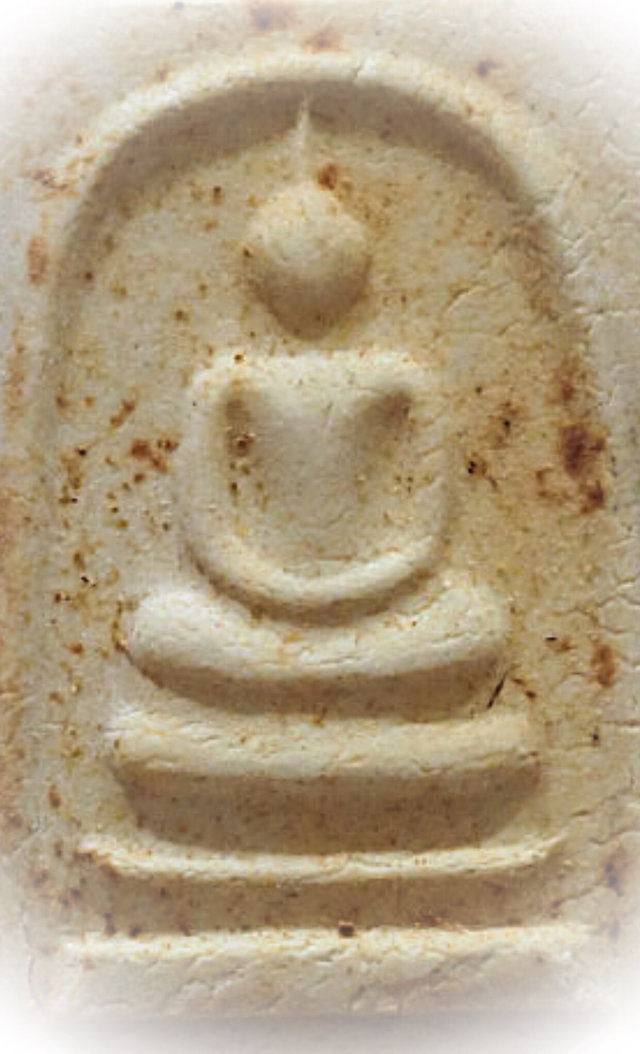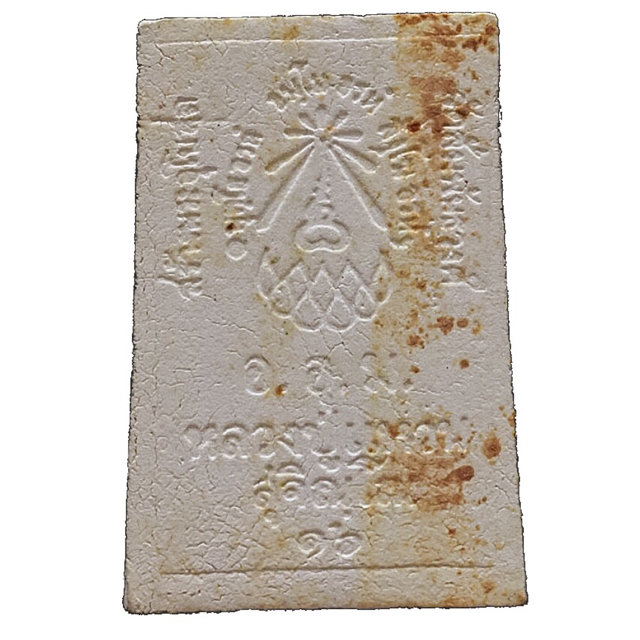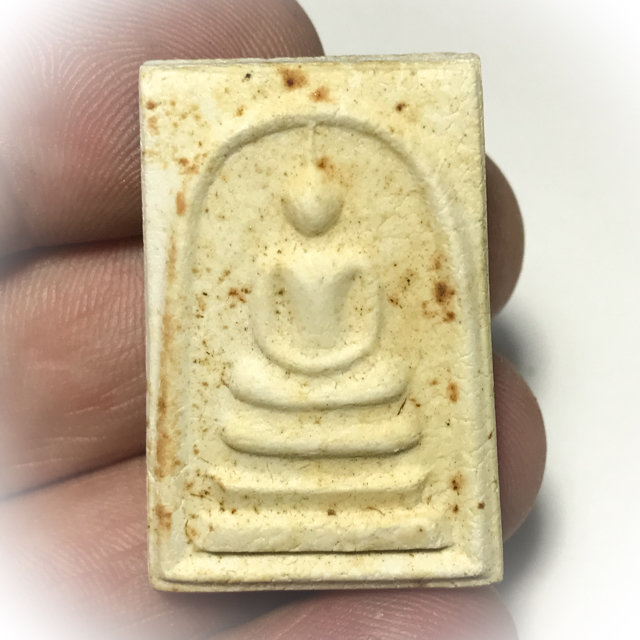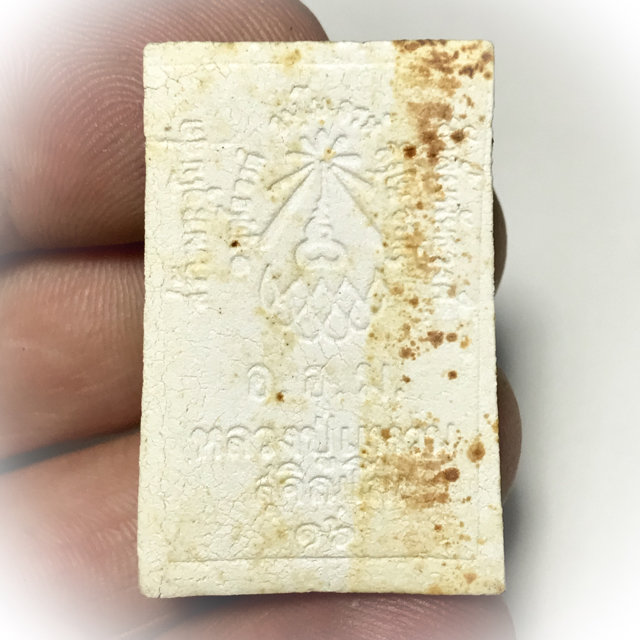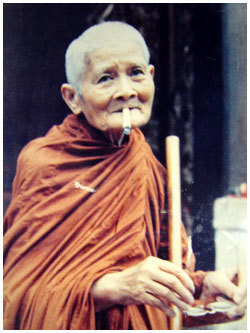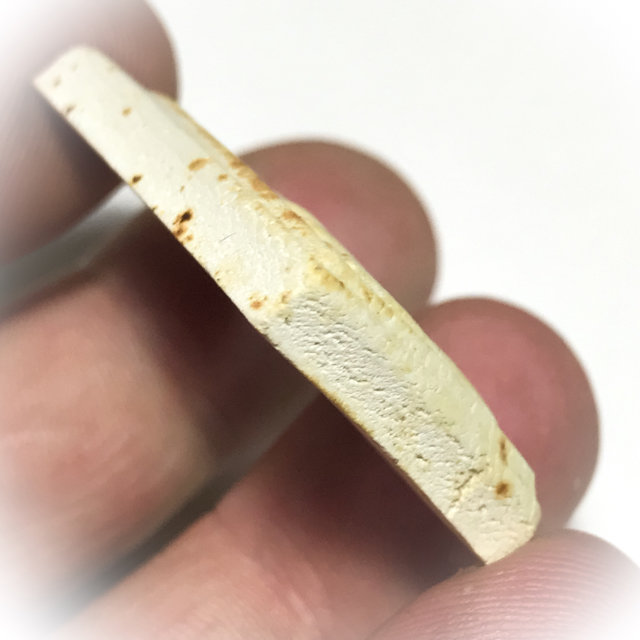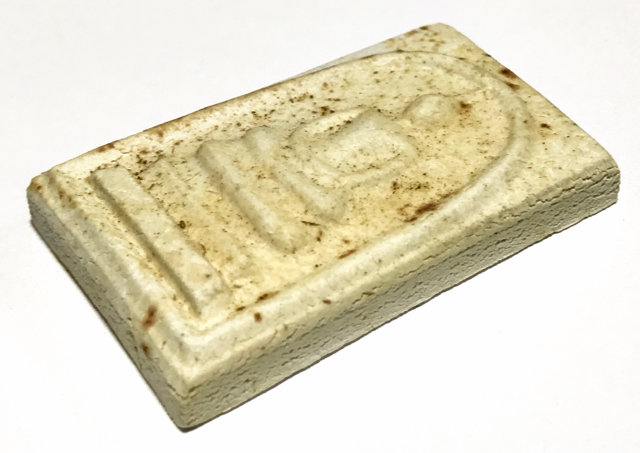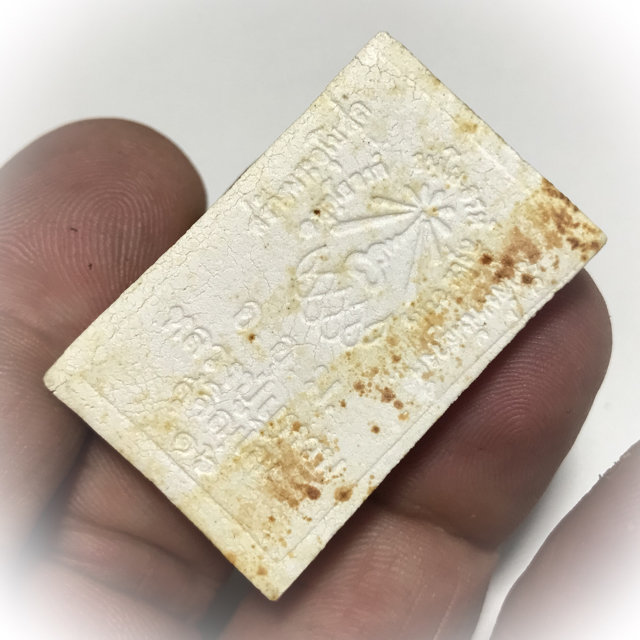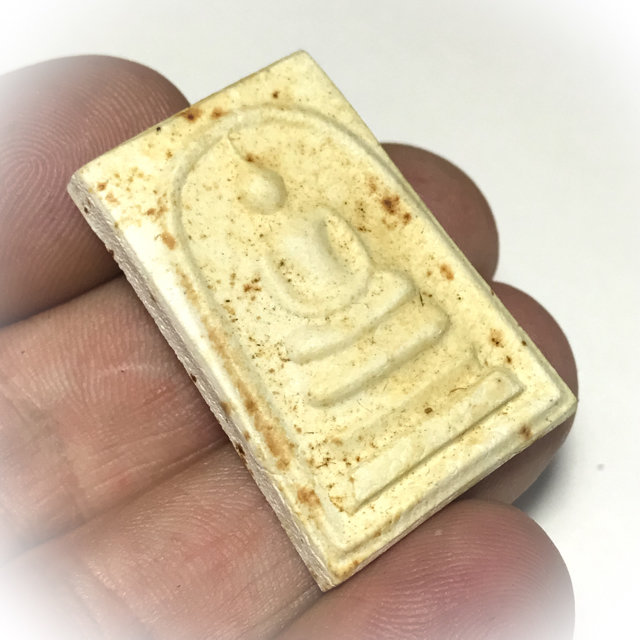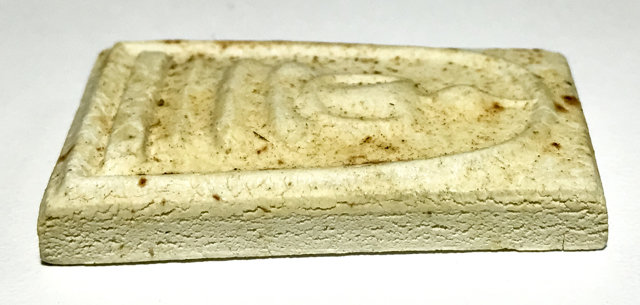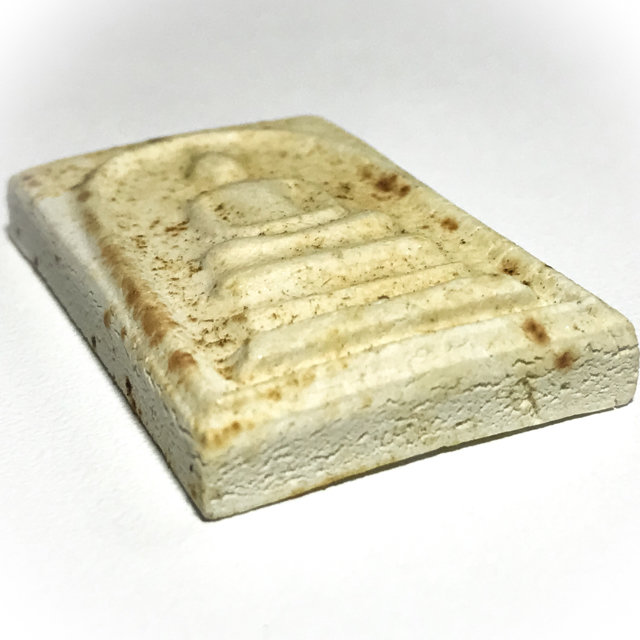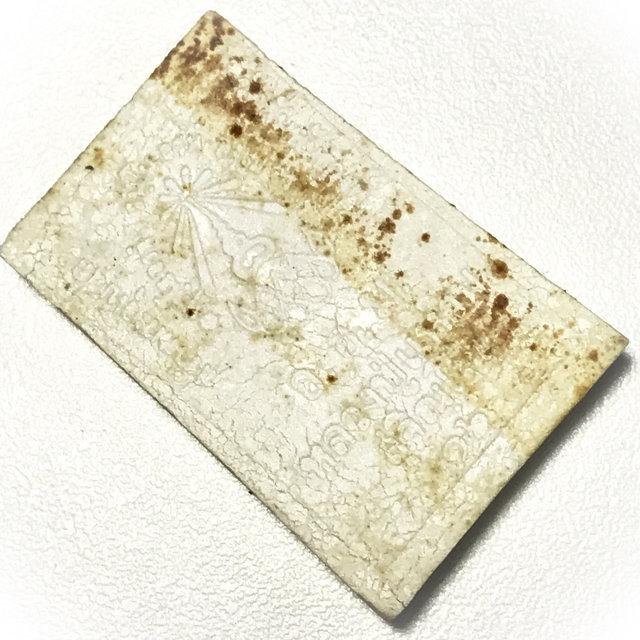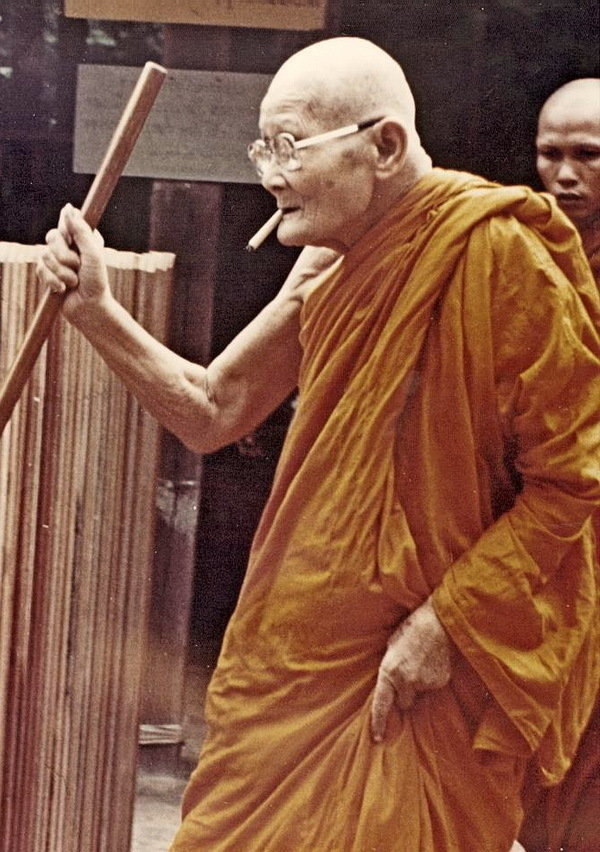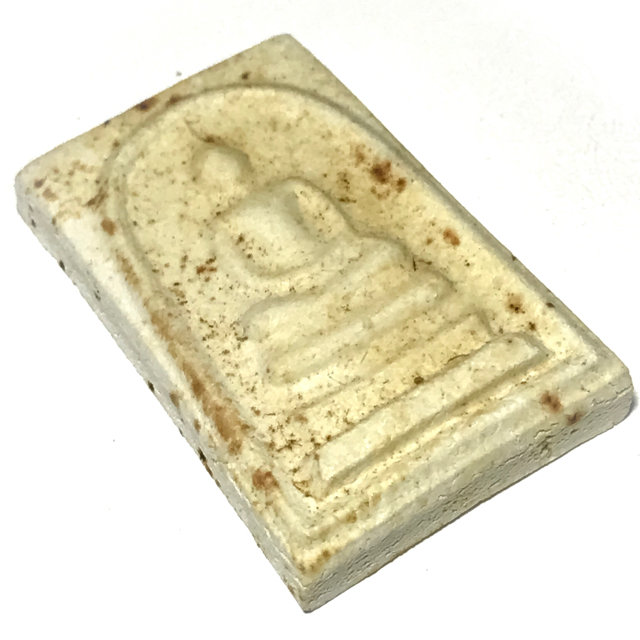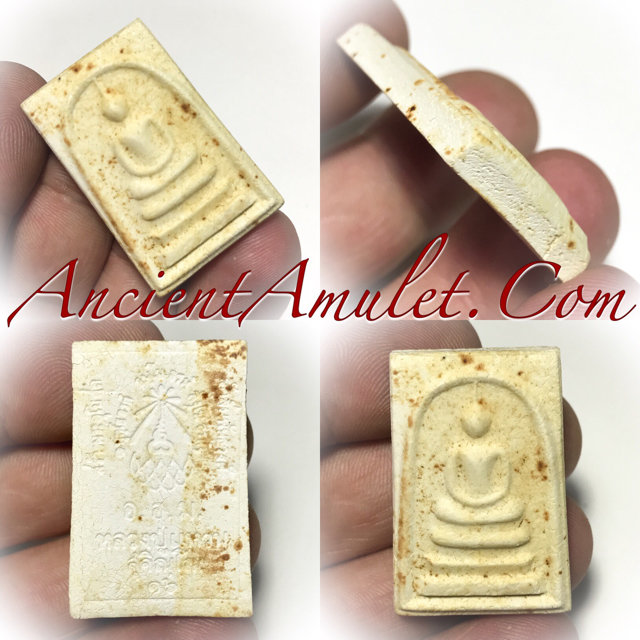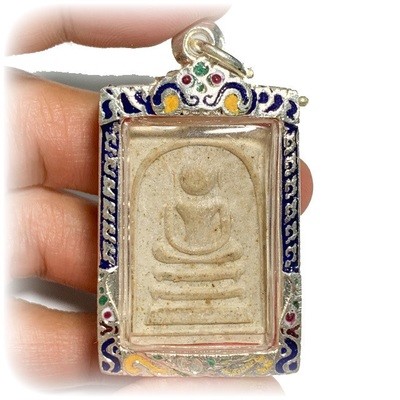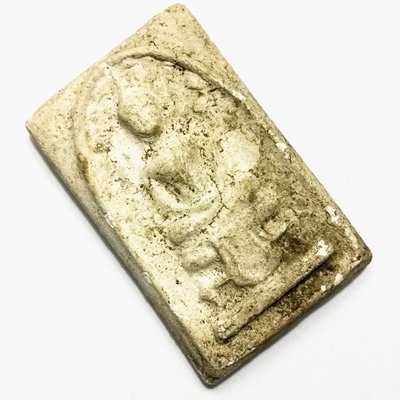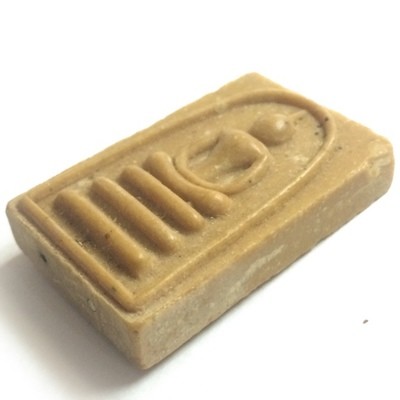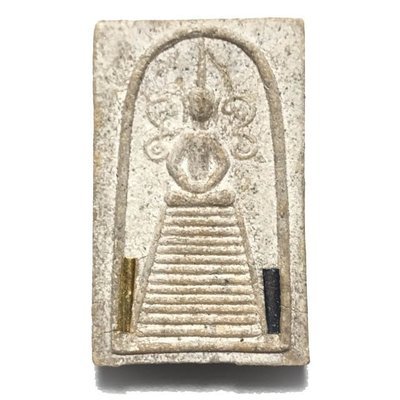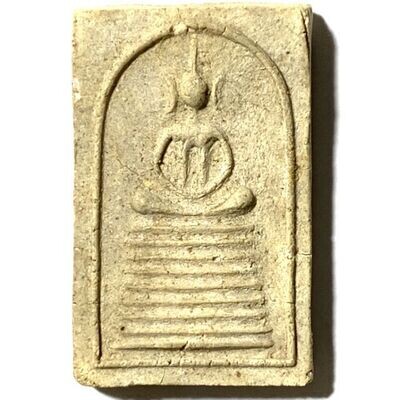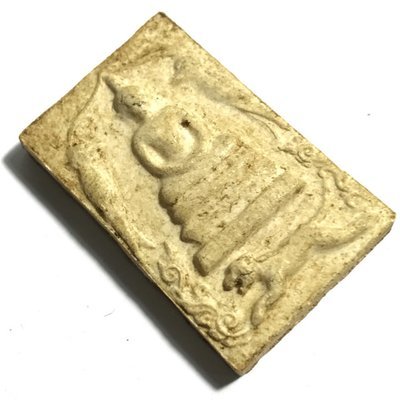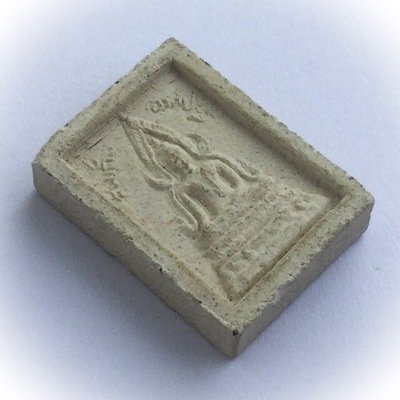Presenting a tiny but powerful and rare classic amulet from one of the Great Khao Or Masters of the 20th Century, Rian Glom Lek Hlang Chedi 2505 BE Nuea Tong Daeng Miniature Guru Monk Coin Por Tan Klai Wajasit
This Sacred amulet of the Great Khao Or Master of Nakorn Sri Tammarat, Master of Wat San Khan and Wat Pratat Noi, is a very rare amulet from Por Tan Klai’s 2505 BE Blessing Ceremony Edition, and is considered a ‘Jaek mae Krua’ type amulet (meaning ‘give to the kitchen maids and temple helpers’), which is suitable not only for men, but due to its miniature size, a perfect amulet for ladies or children to wear.

Rian Glom Lek 2505 BE Por Tan Klai Wajasit Wat Suan Khan
The 2505 BE edition of amulets of Por Tan Klai, is a highly preferred edition, which saw his famous ‘Rian Glom’ round Monk coin amulet with Chakra released, The Rian Glom Lek Hlang Chedi, and the Roop Tai Por Tan Klai Guru Monk Blesséd Photographamulets such as look om chan hmak and ya sen tobacco balls, and sacred powder amulets of various models.
A very rare and highly prized amulet for the devotees of Por Tan Klai to associate with his image and pray to him with a blessed image of the Guru, and the Chedi Relic Stupa on rear face for Buddhanussati and Marananussati. A powerful and Sacred amulet which has passed through the hands of the Guru and been blessed by him.
Por Tan Klai was one of the Top Guru Master Monks of the Last Century, and is considered one of the Four Great Masters of the Previous Generation of Lineage Masters of the Khao Or Southern Sorcery Lineage.
Kata Bucha Por Tan Klai
Pra Somdej Nuea Pong 2516 BE Wat Sampant Wongs Shrineroom Building Edition - Luang Phu Waen Sujinno Wat Doi Mae Pang
This early era Pra Somdej amulet was blessed, by Luang Phu Waen Sujinno of Wat Doi Mae Pang, and released in Buddha Abhiseka Ceremony at Wat sampant Wongs in Bangkok, in the year 2516 BE. This edition wasBlessed by Luang Phu Waen, for the purpose of raising funds to complete the building of the Sala Bprian Dhamma Study Hall at Wat Sarnath Tammaram, in Rayong.
This Wat Sampant Wongs series amulet, was also used to make other series for other temples by Luang Phu Waen, with a different embossment on the rear face to distinguish the editions. One other such edition is the Wat Sarnath Dhamma Study hall Building Edition which used the same block press as the Wat Sampant Wongs series.
This fact reveals just how many temples Luang Phu Waen helped throughout his life, by raising funds releasing his powerful amulets, and preserving Buddhism by his meritorious charitable deeds. The amulet itself is now extremely rare to find, and is a a rare to encounter exhibit for addition to one's collection, especially recommended for collectors and devotees of Luang Phu Hwaen amulets.
The rear face bears an Aura Insignia above a Lotus, with Buddhist Pali Kata Prayers around it. The left side of the rear face has the words 'Sang Bote' (สร้างโปสถ์), meaning 'Building of the Shrineroom'. On the right side of the rear face are the words 'Wat Sampant Wongs' (the name of the temple receiving the funds). Below the Lotus, are the edition code stamps WWM (ววม), and the words 'Luang Phu Hwaen Sujjino' (หลวงปู่แหวนสุจจิโน), and the number 16 (๑๖) for the year of release (2516 BE).
Luang Phu Waen Sujinno (Thai: หลวงปู่แหวน สุจิณโณ, meaning Venerable Grandfather; 16 February 1887 – 2 July 1985) is one of the longest living students of Pra Ajarn Mun Bhuridatta and was a very popular monk in Thailand. He led the Tudong Forest Tradition life, until the point where he could not physically travel any more and had to settle in a forest monastery in the Chiang Mai region. Luang Phu Waen Sujinno was a monk highly skilled in Samadhi and Dhamma.
He disliked crowded places. He loved to live alone in the forests away from people and urbanized areas just like his teacher, Ajarn Mun Bhuridatta. Some people said that Luang Phu Waen had achieved Arahant level. Luang Por Jao Khun Nor had mentioned that "There is a Pra Arahant, but he lives far away, in the forest". Luang Phu Waen was born on 16 February 1883 (BE 2431) in Tambon Na Pong, Mueang District of Loei, Northeast (Isan) of Thailand to a blacksmith's family.He was named Yan, and had one elder sister.
He ordained as a novice in 1892 at Wat Po Chai in Na Pong at the age of nine to fulfill the wish of his mother when she died while he was five years old. At the age of 13, he became a Naen (novice monk) at Wat Poh Chai, Loei province. He studied with teachers and later ordained as a monk at a temple in Hua Taparn District of Ubon Ratchathani at the age of 21. As a novice monk, he studied the Dharma and Pali, even at that young age he showed exceptional ability.
He eventually went Thudong (forest monk) with his teacher, Ajarn Wuhan, travelling from Loei to Ubon Ratchathani, where he remained to learn Dhamma from another teacher, Ajarn Sing. During his Thudong, he met disciples of Ajarn Mun whom he had wanted to further his studies under.
Luang Phu Waen met Ajarn Mun in BE 2462 (at the age of 31) at Bahn Korforest, Udon Thani province. Luang Por Mun Bhuridatta in Udon Thani who taught him the pursuance of a secluded life and the practice of meditation and Dhamma in the jungles. Subsequently Luang Phu Waen travelled widely in the Northeast of Thailand in search of isolated places where he could meditate.
His travelling also took him to Bangkok where he met Chao Khun Phra Upali Gunupamacariya of Wat Bowonniwet in 1921 with whom Luang Phu Waen spent several years studying and practising the Dhamma. Later Chao Khun Phra Upali took him to Wat Chedi Luang in Chiang Mai where Luang Phu Waen decided to change from the Maha-Nikaya sect of Buddhism to the stricter Dhammayut sect. Later he went Thudong again with Ajarn Dteu. During his Tudong, he encountered ghosts, wild animals and other dangers but was never afraid despite warnings from local villagers. It was his wish to experience and learn from everything.
Luang Phu Waen spent most of his monkhood as a forest monk, travelling from one province to another on foot, climbing hills, crossing rivers and deep forests. He had also gone as far as Laos, Cambodia, Burma and even Vietnam on Thudong. At BE 2470, age 39, Luang Phu Waen arrived in Lampang. He met another disciple of Ajarn Mun called Ajarn Keow.
He was told that Ajarn Mun was in Chiang Mai. Luang Phu Waen quickly Thudong to Chiang Mai to look for Ajarn Mun. Finally he met Ajarn Mun and Ajarn Dteu at Wat Chedi Luang. Ajarn Mun officially accepted Luang Phu Waen as his disciple. He studied Dhamma at Wat Chedi Luang. After Ajarn Mun left Wat Chedi Luang for Thudong, Luang Phu Waen also went Thudong in Chiang Mai. He stayed at Wat Huainumrin in Chiang Mai Province for 10 years. During his long stay in Wat Huainumrin, he stayed most of his time in forests and only returning to the temple during the rainy seasons (Khao Phansa).
Luang Phu Waen travelled extensively by foot through jungles and across mountains and ventured to Burma and India where he paid homage to several historic Buddhist sites. However, in 1955 news of a foot injury sustained during his stay in seclusion of Wat Paa Ban Pong in Mae Tang District, Chiang Mai, reached Pra Ajarn Noo Suchitto of Wat Doi Mae Pang who later arranged for Luang Phu Waen to stay in Wat Doi Mae Pang permanently. He resided in Wat Doi Mae Pang until his death in 1985.
Above; Luang Ta Maha Boowa bows to the Great Luang Phu Waen Sujjino during a visit
Luang Phu Waen entered Maharaj Hospital on 15 April 1985 when he was found unable to eat or move and was operated on 4 June 1985 in order to feed him through a tube which was inserted into his stomach. However, complications developed and Pra Ajarn Noo, the abbot of Wat Doi Mae Pang, requested doctors not to perform any more operations as he wanted Luang Phu Waen to rest peacefully.
His request was accepted by doctors and the Chiang Mai Governor, Mr. Chaiya Punsiriwong. On 2 July 1985 at 9:54 pm, Luang Phu Waen finally died at the age of 98 years and 5 months after having been in the monkhood for almost 90 years.

Luang Phu Waen entered Maharaj Hospital on 15 April 1985 when he was found unable to eat or move and was operated on 4 June 1985 in order to feed him through a tube which was inserted into his stomach. However, complications developed and Pra Ajarn Noo, the abbot of Wat Doi Mae Pang, requested doctors not to perform any more operations as he wanted Luang Phu Waen to rest peacefully. His request was accepted by doctors and the Chiang Mai Governor, Mr. Chaiya Punsiriwong. On 2 July 1985 at 9:54 pm, Luang Phu Waen finally died at the age of 98 years and 5 months after having been in the monkhood for almost 90 years.
He was given a royal-sponsored bathing ceremony at Sala Ang Klaew in Chiang Mai University which was attended by the King and Queen of Thailand as well as the general public. His remains were cremated at a Royal Funeral on 16 January 1986. "Sujinno Building", a 15-level building of Maharat Nakhon Chiang Mai Hospital, was named in his honor.
Kata Ārātanā Pra Krueang
Famous Saying of Luang Phu Waen
“What is sacred? Everyone has something sacred within themselves. To have been born as a complete human being is already sacred. One can be sacred only from within oneself, and not by any amulet or other so-called sacred objects. Dhamma is sacred, and to have this sacredness, one must have Dhamma within oneself.”
The most remarkable characteristic of Luang Phu Waen, was his dislike of crowded places. He loved to live alone in the forests away from people and urbanized areas just like his teacher, Ajahn Mun Bhuridatta. Some people say that Luang Phu Waen had achieved Arahantship. Tahn Jao Khun Nor had in fact mentioned that "There is a Pra Arahant, but he lives far away, in the forest", and that this referred to Luang Phu Waen.
As a very popular monk, Luang Phu Waen is often rumoured to have “sacred amulets” - something which Thai people from all walks of life like to receive from revered monks - for their protective value. People from all over Thailand would often travel to Wat Doi Mae Pang to seek these amulets or other sacred objects from him. He would always give the same answer as the one quoted above.) Wat Doi Mae Pang (Thai: วัดดอยแม่ปั๋ง) is a Buddhist temple in Phrao district, Chiang Mai Province, northern Thailand.
It is some 75 kilometres from the city Chiang Mai,on route 1001 towards Phrao. Local legends say that the road 1001 was built due to Luang Por Waen Sujinno. Legend tells of this monk meditating and floating hundreds of feet into the air. He was seen by helicopter pilot, and the King was said to be so astonished, that he realized a road must built to this holy place.
The locals have variations of this tale but any tourists in the area will hear this as the reason for Road 1001 being built. Its greatest claim to fame is that it was the home to Luang Por Waen Sujinno. Many of the buildings are of wooden construction, including the viharn and a hermit's cell called Rong Yang Kiles or Rong Fai. Relics of Luang Por Waen Sujinno include his dwelling hut, a picture in the pavilion that shows him meditating, and a square-shaped, spire-roofed museum with his ashes, a wax model of the monk, and his personal effects.

